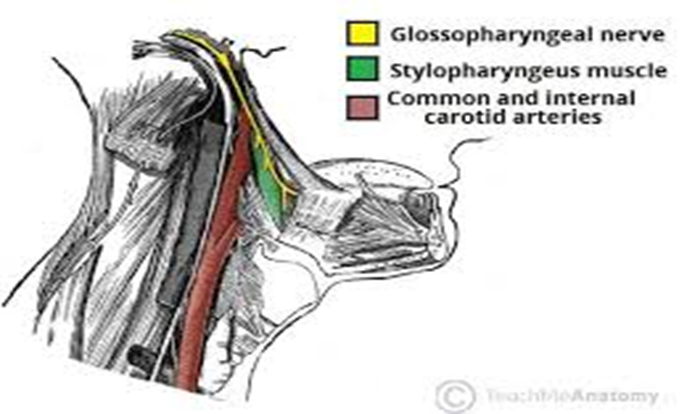What cranial nerve is responsible for the taste sensation of the posterior third of the tongue?

Facial
Abducens
Glossopharyngeal
Hypoglossal
The Correct Answer is C
Choice A Reason:
The facial nerve, or cranial nerve VII, is responsible for the taste sensation in the anterior two-thirds of the tongue, not the posterior third. It carries taste sensations from the front part of the tongue via the chorda tympani branch.
Choice B Reason:
The abducens nerve, or cranial nerve VI, has no role in taste sensation. It is primarily involved in controlling the lateral rectus muscle of the eye, which abducts the eye.
Choice C Reason:
The glossopharyngeal nerve, or cranial nerve IX, provides special sensory innervation for taste to the posterior third of the tongue. This enables the sensation of various tastes like salty, sweet, sour, and bitter in this region.
Choice D Reason:
The hypoglossal nerve, or cranial nerve XII, is responsible for motor control of the tongue muscles but does not provide sensory innervation for taste.
Nursing Test Bank
Naxlex Comprehensive Predictor Exams
Related Questions
Correct Answer is C
Explanation
Choice a reason:
The left temporal bone would be the expected site of lateralization for sound in a Weber test if the patient had conductive hearing loss in the left ear. However, with unilateral sensorineural hearing loss, the sound typically lateralizes to the opposite ear, which is the ear with better hearing.
Choice b reason:
Lateralization to both ears equally during the Weber test would suggest either normal hearing or symmetrical hearing loss. In the case of unilateral sensorineural hearing loss, the sound is not perceived as equal in both ears because the affected ear does not hear as well as the unaffected ear.
Choice c reason:
In a patient with unilateral sensorineural hearing loss in the left ear, the Weber test will lateralize to the right ear, which is the ear with normal hearing. This occurs because the inner ear on the affected side is not able to transmit the sound as effectively as the unaffected side, making the sound seem louder in the ear with better hearing.
Choice d reason:
Lateralization to the left ear in the Weber test would indicate conductive hearing loss in the left ear, not sensorineural hearing loss. In sensorineural hearing loss, the sound vibrates to the ear with better cochlear function, which would be the right ear in this case.
Correct Answer is B
Explanation
Choice A Reason:
Tracheal sounds are harsh, high-pitched breath sounds typically heard over the trachea in the neck. They are not expected to be heard over the peripheral lung fields of a young adult during a routine lung auscultation.
Choice B Reason:
Vesicular breath sounds are the normal sounds heard over most of the lung fields. They are characterized by a soft, low-pitched, rustling sound during inhalation and are softer during exhalation. These sounds are created by air moving through the smaller airways such as the bronchioles and alveoli.
Choice C Reason:
Bronchovesicular sounds are heard over the major bronchi and are characterized by a moderate pitch and intensity. They are typically heard between the first and second intercostal spaces at the sternal border anteriorly and between the scapulae posteriorly, not over most of the lung fields.
Choice D Reason:
Bronchial breath sounds are high-pitched and louder than vesicular sounds, with a hollow quality, and are normally heard over the manubrium. If heard over the peripheral lung fields, they may indicate lung consolidation or other abnormalities.
Whether you are a student looking to ace your exams or a practicing nurse seeking to enhance your expertise , our nursing education contents will empower you with the confidence and competence to make a difference in the lives of patients and become a respected leader in the healthcare field.
Visit Naxlex, invest in your future and unlock endless possibilities with our unparalleled nursing education contents today
Report Wrong Answer on the Current Question
Do you disagree with the answer? If yes, what is your expected answer? Explain.
Kindly be descriptive with the issue you are facing.
